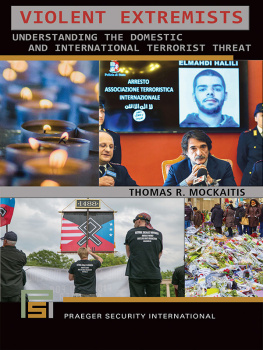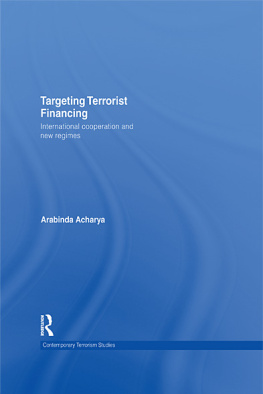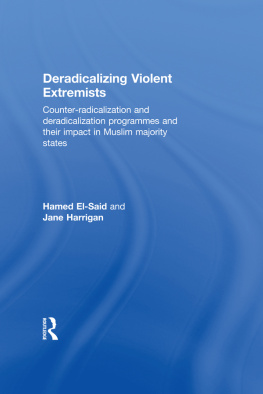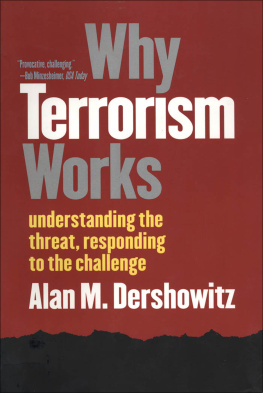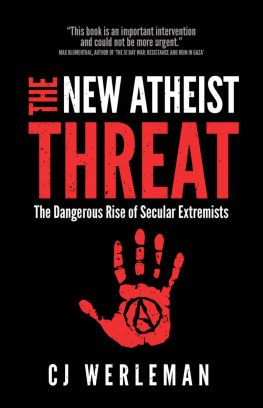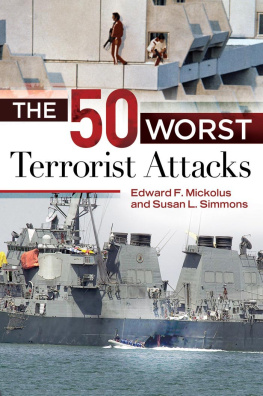Mockaitis - Violent extremists : understanding the domestic and international terrorist threat
Here you can read online Mockaitis - Violent extremists : understanding the domestic and international terrorist threat full text of the book (entire story) in english for free. Download pdf and epub, get meaning, cover and reviews about this ebook. City: USA, year: 2019, publisher: ABC-CLIO, genre: Politics. Description of the work, (preface) as well as reviews are available. Best literature library LitArk.com created for fans of good reading and offers a wide selection of genres:
Romance novel
Science fiction
Adventure
Detective
Science
History
Home and family
Prose
Art
Politics
Computer
Non-fiction
Religion
Business
Children
Humor
Choose a favorite category and find really read worthwhile books. Enjoy immersion in the world of imagination, feel the emotions of the characters or learn something new for yourself, make an fascinating discovery.
Violent extremists : understanding the domestic and international terrorist threat: summary, description and annotation
We offer to read an annotation, description, summary or preface (depends on what the author of the book "Violent extremists : understanding the domestic and international terrorist threat" wrote himself). If you haven't found the necessary information about the book — write in the comments, we will try to find it.
Mockaitis: author's other books
Who wrote Violent extremists : understanding the domestic and international terrorist threat? Find out the surname, the name of the author of the book and a list of all author's works by series.
Violent extremists : understanding the domestic and international terrorist threat — read online for free the complete book (whole text) full work
Below is the text of the book, divided by pages. System saving the place of the last page read, allows you to conveniently read the book "Violent extremists : understanding the domestic and international terrorist threat" online for free, without having to search again every time where you left off. Put a bookmark, and you can go to the page where you finished reading at any time.
Font size:
Interval:
Bookmark:
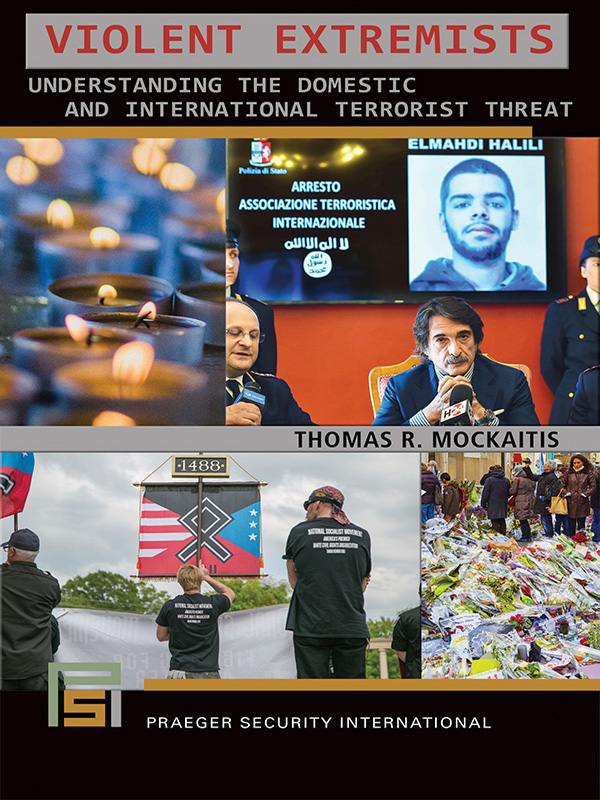
Violent Extremists
Violent Extremists
Understanding the Domestic and International Terrorist Threat
THOMAS R. MOCKAITIS
Praeger Security International

Copyright 2019 by Thomas R. Mockaitis
All rights reserved. No part of this publication may be reproduced, stored in a retrieval system, or transmitted, in any form or by any means, electronic, mechanical, photocopying, recording, or otherwise, except for the inclusion of brief quotations in a review, without prior permission in writing from the publisher.
Library of Congress Cataloging-in-Publication Data
Names: Mockaitis, Thomas R., 1955 author.
Title: Violent extremists : understanding the domestic and international terrorist threat / Thomas R. Mockaitis.
Description: Santa Barbara : Praeger/ABC-CLIO, [2019] | Series: Praeger security international | Includes bibliographical references and index.
Identifiers: LCCN 2019007383 (print) | LCCN 2019011751 (ebook) | ISBN 9781440859496 (eBook) | ISBN 9781440859489 (print : alk. paper)
Subjects: LCSH: RadicalismUnited States. | RadicalismReligious aspectsIslam. | White supremacy movementsUnited States. | TerrorismPreventionUnited States.
Classification: LCC HN49.R33 (ebook) | LCC HN49.R33 M63 2019 (print) | DDC 303.48/4dc23
LC record available at https://lccn.loc.gov/2019007383
ISBN: 978-1-4408-5948-9 (print)
978-1-4408-5949-6 (ebook)
23 22 21 20 19 1 2 3 4 5
This book is also available as an eBook.
Praeger
An Imprint of ABC-CLIO, LLC
ABC-CLIO, LLC
147 Castilian Drive
Santa Barbara, California 93117
www.abc-clio.com
This book is printed on acid-free paper 
Manufactured in the United States of America
In Memoriam:
Gene Robkinmentor, colleague, and friend
Contents
Almost 30 years have gone by since I wrote my first book. Published at the end of the Cold War, British Counterinsurgency, 19191960 (London: Macmillan, 1990) was well received as an historical work. However, many experts questioned its relevance to the contemporary world. Insurgency and terrorism, they insisted, belonged to a dead colonial past. Unfortunately, the collapse of the Soviet Union did not herald an era of peace, as many had hoped and some expected, but rather a new period of uncertainty. The power vacuum caused by the withdrawal of the United States and Soviet Union from many areas led to a series of brutal civil conflicts. The failure of the Somali state, the breakup of Yugoslavia, and the Rwandan genocide occurred in rapid succession. Then came the shock of the Oklahoma City bombing, attacks on the U.S. embassies in Kenya and Tanzania, and, of course, 9/11. The United States has been at war since the end of 2001. We live in an era of continuous, low-level conflict with no end in sight.
The world has given me plenty to write about over the past three decades. This book, like several of its predecessors, has a simple purpose: to situate a pervasive threat in a healthy context, replacing ignorance and fear with understanding. Although it avoids political opining, it does challenge the fearmongering done by some politicians. I argue that terrorism is a persistent problem but not an existential threat and that domestic extremism is more worrisome than international terrorism. Many politicians and commentators tend to exaggerate the former and downplay or even ignore the latter. The book concludes with suggestions on how to counter the threat of extremism, particularly the ideology that fuels it.
The decades have seen as much change in my own life as in the world. When I published my first book, I was the proud father of three young sons. I am now the doting grandfather of two grandsons and two granddaughters. Along with my students, these family members keep me optimistic about the future. They also motivate me to work hard so that the future remains bright for them long after I am gone.
As with any such undertaking, I have amassed a considerable debt of gratitude to the people who have supported me in writing this book. My colleagues at the Center for Civil-Military relations have been a source of encouragement and a sounding board for ideas. My department has always supported and recognized my scholarly work. My graduate student assistant, Prashant Jivanlal Varia, from the DePaul College of Computers and Digital Media did excellent research for the section on cyberterrorism. DePaul University funded his position. Last but certainly not least, my wonderful wife of 38 years, Martha Ross-Mockaitis, has been a constant source of love and support through the long and at times frustrating task of research and writing.
As I was completing the manuscript, my dear friend Gene Robkin died. Many times, as I was working through ideas for this manuscript, I wanted to discuss them with him, as I had with so many other projects in the past. In appreciation of his guidance and friendship, I am dedicating this book to him. The last thing he said to me before he died was, Speak truth to power. I always will, but it wont be as easy without his wisdom and encouragement.
In 2007, I published The New Terrorism: Myths and Reality with a very specific purpose in mind. The book aimed to debunk a popular myth. In the aftermath of 9/11, a bevy of newly minted experts loudly proclaimed the uniqueness of the al-Qaeda phenomenon and, along with the media, exaggerated the threat it posed to the United States and its people. I sought to demonstrate how, contrary to popular belief, terrorism had been evolving over the preceding decades and to place it in a healthy perspective relative to other threats. I aimed to separate the new from the old characteristics of the phenomenon and to situate terrorism within the broad spectrum of security risks facing the United States. Above all, I wanted to dampen down the pervasive fear that had so many people convinced that they could become victims at any moment.
Like its predecessor, this book also aims to debunk myths and to situate contemporary terrorism in the context of threats facing the United States. Over the past decade, the myths have changed, but the fear remains, intensified by a new populist political rhetoric that seeks scapegoats to blame for the countrys problems. This rhetoric exaggerates the threat posed by the Islamic State in Iraq and Syria (ISIS), encourages fear of immigrants, and creates an atmosphere of Islamophobia, which makes it easier for ISIS to recruit followers. Ironically, many of the same people who hype the Islamist threat tend to ignore or dismiss the more serious danger posed by domestic hate groups. Rather than see homegrown, racially motivated violence as terrorism, they discount it as the work of lone wolvesunstable individuals acting alonerather than as part of a larger pattern of violence encouraged by the inflammatory rhetoric of a broad ideological movement whose ideas some groups have explicitly embraced and many individuals tacitly accept.
Public opinion polls corroborate this distorted view of terrorism. A spring 2017 survey conducted by the Pew Charitable Trust found that 42 percent of Americans were very concerned about Islamist extremism, and another 30 percent were somewhat concerned. To the death toll must be added 13 more victims killed in 2018: 11 members of the Tree of Life Synagogue in Pittsburgh and 2 African Americans murdered by a white supremacist in Louisville.
Font size:
Interval:
Bookmark:
Similar books «Violent extremists : understanding the domestic and international terrorist threat»
Look at similar books to Violent extremists : understanding the domestic and international terrorist threat. We have selected literature similar in name and meaning in the hope of providing readers with more options to find new, interesting, not yet read works.
Discussion, reviews of the book Violent extremists : understanding the domestic and international terrorist threat and just readers' own opinions. Leave your comments, write what you think about the work, its meaning or the main characters. Specify what exactly you liked and what you didn't like, and why you think so.

